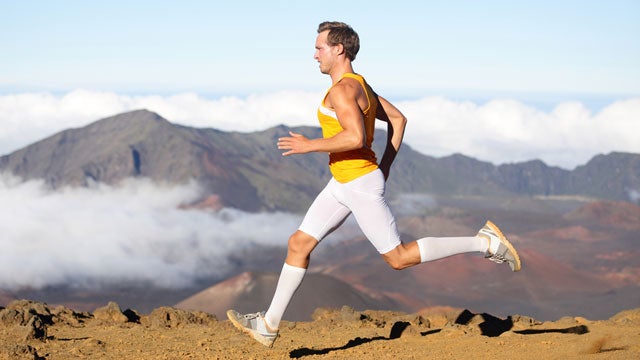What works in the lab doesn’t always work in the field, and sometimes great athletes don’t follow the most recent scientific advice. Coach and distance-running great Alberto Salazar and CrossFit champ Samantha Briggs offer some tips that don’t boast any scientific proof but do contain the ethos of two supreme athletes. Their recommendation? Easy days in-between the pain.
Rest and Recovery
Salazar says:
The day after a tough workout, the most you want to do is jog lightly or do some form of cross-training, like cycling. You need a recovery day after a hard day. No exceptions.
Briggs concurs:
I typically train every day but two of these will be lower intensity or active recovery days. The normal training day will be broken into two sessions, both ranging from two to three hours, depending on loads or intensity of training employed. I try to mix the training up as much as I can. I don’t typically have a complete rest day—I’ll have active recovery days where I enjoy getting out on my bike, going swimming, or skiing.
What is Active Rest?
Active rest is essentially a day of light exercise, potentially with some stretching or form drills—sort of like an extended warm-up. For runners, it might mean 30 minutes of jogging and some faster-paced strides; for cyclists, some easy spinning; and for swimmers, an easy warm-up followed by form drills. The idea is that it takes your muscles 48–72 hours to recover from the micro-damage associated with hard training sessions, so you’ll need to dial it down those few days for your body to catch up. Not to mention, getting the most out of hard training requires the mental energy to really push.
The need for rest is generally accepted but not always applied, as some coaches and athletes mindlessly equate more work with better results.
So what does the science say about rest? In short, it doesn’t say much. Most training studies are short-term, lasting a few months at the most. Defining an optimum pattern would take a long-term study on many serious athletes, and determining an outcome wouldn’t be easy. Would success mean a faster time, less injury, a better attitude?
In this case, the athletes may be ahead of the science. Both Salazar and Briggs stress the importance of consistency, and if you’re injured or burnt out, it’s nearly impossible to be consistent.
Recovery and Compression Stockings
Beyond active rest, the endurance world is full of strategies and aids that claim to increase speed or enhance recovery. Compression stockings have especially gained popularity. There are a number of good studies on them, with some on running performance and others . One study at the end of a simulated race, but no effect on the race performance:
The change in pre to postexercise jump performance was lower in low and medium compression stockings than in control. Mean heart rate and blood lactate were not different between trials…. In conclusion, GCS worn by competitive runners during 10-kilometer time trials did not affect performance time; however Low and Med GCS resulted in greater maintenance of leg power (vertical jump) after endurance exercise.
This conclusion received support from an :
When compression clothing was applied for recovery purposes after exercise, small to moderate effect sizes were observed in recovery of maximal strength and power, especially vertical-jump exercise; reductions in muscle swelling and perceived muscle pain; blood lactate removal; and increases in body temperature. These results suggest that the application of compression clothing may assist athletic performance and recovery in given situations with consideration of the effect’s magnitude and practical relevance.
In practice, this means that compression stockings could give you a little more snap in the legs and help with the final push at the end of a race. To learn more, I contacted who participates in multi-day endurance events. He, too, has studied the effect of compression clothing. In an extended e-mail, he commented:
As with all of these novelty ergogenic aids, the placebo effect is probably alive and well, and the true effects are generally small and perhaps reflecting some publication bias (for positive results)…. Would have been good to see more of the effects on recovery outcomes done in blinded designs and subjects who’re already well trained in the muscle-damaging interventions! Some of the vertical jump data are for effectively wetsuit shorts, which has the danger of being extrapolated into dissimilar garments.
One-Percent Solution
The effect of compression clothing, if there is one, is small. But it bears remembering that a one-percent edge in a ten-kilometer race is worth 100 meters in distance, and one-percent differences are very difficult to measure in the lab. Much of self-improvement is eking out the last bit of marginal gain in whatever you’re doing: making your bike more aerodynamic, perfecting your swim stroke, tweaking your diet, or investing in light-weight equipment and clothing.
Making These Ideas Work For You
Here are some tips for adding rest and recovery to your routine:
1) Develop a pattern of “hard day, easy day” and stick to it.
2) If you have a long day at work or other obligations ahead of you, pre-schedule an easy workout for that day.
3) Many do more training and racing over the weekend, so consider making Fridays and Mondays designated easy days.
4) Experiment with compression stockings and other recovery aids—but remember the placebo effect (unless that’s counteractive, in which case, don’t). Truthfully, if technology makes a difference, it is likely small and not a substitute for an easy day.
5) Multi-sport athletes, beware: Don’t turn the fact that you can train in a variety of disciplines into an excuse to go hard almost every day.
6) When in doubt, sit on a stationary bike and spin for 30 minutes.
Michael J. Joyner, M.D., is a physiologist and anesthesiologist at the Mayo Clinic and a leading voice in the world of exercise physiology. Over the past 25-plus years, he’s published hundreds of studies, many of which have focused on how humans respond to exercise. Dr. Joyner also writes at . The views expressed in his posts are his own and do not reflect those of his employer.


